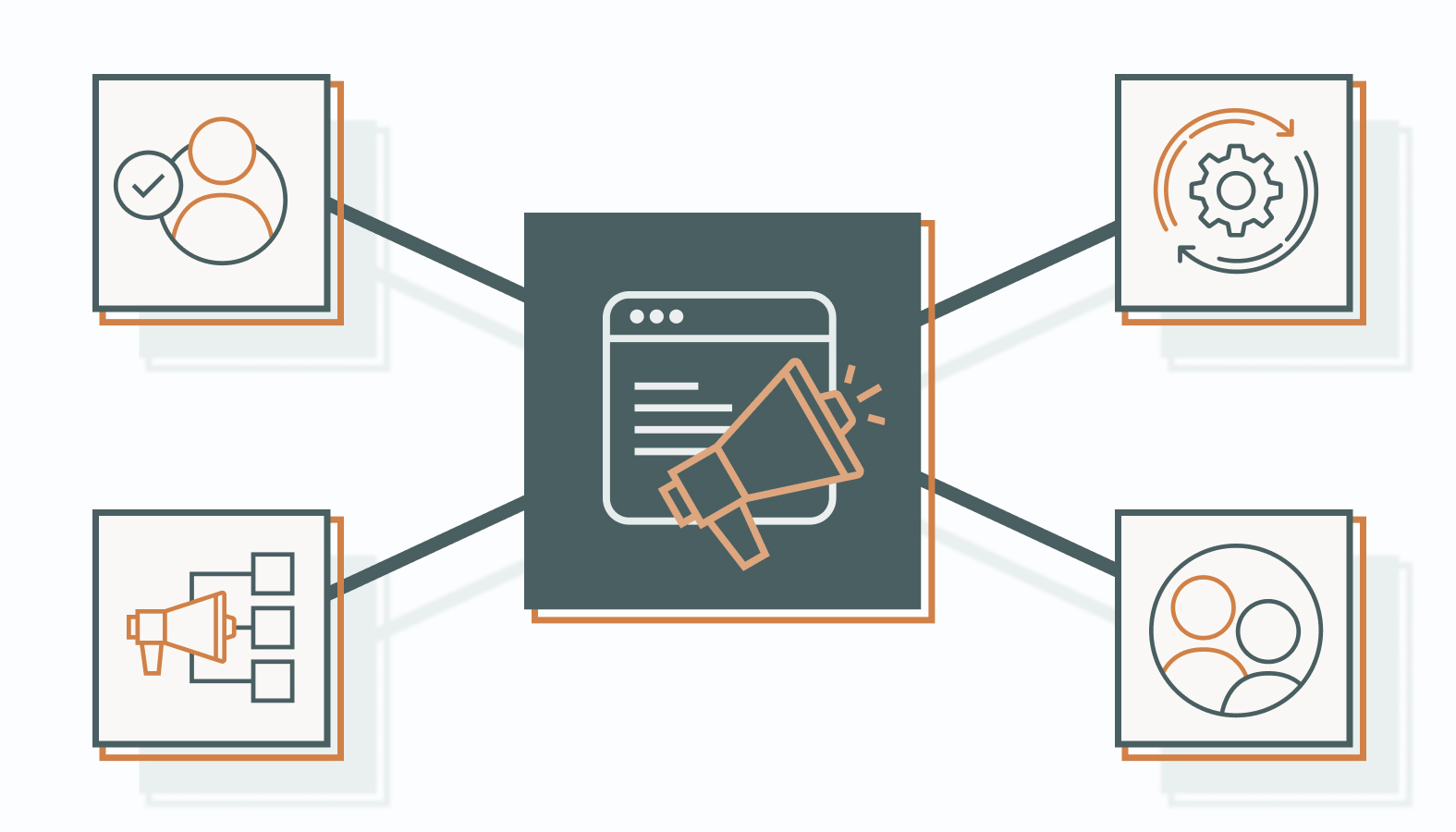B2B marketing often feels like shouting into a crowded room — plenty of noise, but not much real connection. That’s why many organizations are turning to an account-based marketing strategy, which flips the script by focusing on the accounts that matter most. Instead of chasing every lead, you concentrate resources on high-value targets and create personalized experiences that actually resonate.
The challenge? Building and executing this strategy requires more than good intentions. It calls for precise targeting, tight alignment between sales and marketing, and the smart use of data and technology. Without those pieces in place, even the most ambitious ABM efforts fall flat.
This article breaks down how to structure a winning ABM approach, from identifying the right accounts to measuring success. Let’s start by understanding what ABM really is and why it has become such a driving force in modern B2B growth.
Account-Based Marketing 101
Account-Based Marketing (ABM) takes a different path from traditional lead generation. Instead of broad outreach, it zeroes in on the accounts that can deliver the greatest business impact.
For B2B organizations, this focus makes ABM one of the most effective ways to drive growth, align teams, and maximize resources.
What is ABM?
ABM is a structured marketing approach that designs campaigns for specific, high-value accounts rather than the market at large. The goal is not just lead capture, but building relevance. You must understand each account’s priorities and tailor solutions that directly address them.
When done well, ABM moves beyond messaging to create targeted experiences that drive meaningful engagement.
The strategy also requires tight coordination with sales. By aligning outreach, both teams deliver consistent communication and positioning that resonates with decision-makers. This integration increases the odds of conversion and helps establish partnerships that last.
The Benefits of ABM
Adopting an ABM framework offers measurable advantages:
- Higher ROI: Resources are directed to the accounts most likely to convert, producing stronger returns than broad marketing.
- Stronger Relationships: Personalized engagement builds trust and credibility, deepening ties with priority clients.
- Smarter Resource Use: Efforts are concentrated on fewer, higher-value opportunities, improving efficiency across teams.
When sales and marketing operate in sync under ABM, organizations create a unified engine for revenue growth. The approach shifts teams from chasing volume to building strategic wins that compound over time.
Building a Foundation for ABM Success
A strong ABM program starts with structure. Success depends on clarity: clear goals, clear target accounts, and clear collaboration between teams.
Without a solid foundation, even the most sophisticated tactics risk missing the mark. The groundwork comes down to disciplined account selection, effective use of data, and ongoing sales-marketing alignment.
Identifying Target Accounts
The strength of any ABM plan hinges on picking the right accounts. Selection isn’t about chasing every potential customer; it’s about prioritizing those that fit both opportunity and capacity.
The process should balance growth potential with business priorities to ensure that resources are directed toward accounts with the greatest likelihood of impact.
Criteria for Selection
Account selection must be data-led, not gut feel. Core factors typically include:
- Company Size: Fit with your delivery capacity and offering.
- Industry Relevance: Sectors where your expertise delivers outsized value.
- Revenue Potential: Accounts with meaningful upside, not just volume.
Data sharpens these filters. Clean, current insights reduce wasted effort and make it easier to focus on accounts that align with long-term strategy.
Tools for Account Identification
Technology accelerates the selection process.
Platforms like LinkedIn Sales Navigator, ZoomInfo, and HubSpot provide filtering, firmographics, and buying signals that help teams validate targets.
Used properly, these tools allow for more precise account mapping and eliminate assumptions.
Aligning Accounts with Business Goals
Targets should evolve as business goals shift.
Regular reviews and feedback loops keep account lists current and prevent drift. This ensures teams remain focused on accounts that actually support the company’s growth strategy rather than outdated priorities.
The Role of Data in ABM
Data is the operating system of ABM; it informs targeting, personalization, and timing. Strong data discipline turns ABM from a marketing wish list into a measurable business driver.
Data Collection Techniques
Effective programs combine multiple sources:
- Surveys: Direct signals from the accounts themselves.
- CRM Systems: Behavioral patterns and relationship history.
- Third-Party Data: Broader context from industry and market sources.
Every collection method must meet compliance standards like GDPR, as trust and credibility are non-negotiable.
Analyzing Account Insights
Raw data only matters if it produces insight. Segmentation and trend analysis reveal patterns: who buys, when they buy, and what triggers action. These insights fuel campaigns that speak to specific needs rather than generic pain points.
Leveraging Predictive Analytics
Predictive models take this further by forecasting account behavior.
By studying historical patterns, teams can anticipate future demand and position solutions ahead of the curve. The result: more relevant outreach and higher engagement rates.
Collaboration Between Sales and Marketing
ABM succeeds when sales and marketing work as one.
Disjointed efforts confuse prospects and waste resources; integrated efforts build momentum.
Collaboration ensures both teams are focused on the same accounts, using the same playbook.
Establishing Communication Channels
Shared dashboards, real-time messaging tools, and recurring check-ins prevent silos. Transparency enables faster decisions and more consistent execution.
Joint Planning and Strategy Sessions
Planning together sharpens strategy. Sessions should move beyond pipeline updates and into coordinated plays, with clear agendas and defined outcomes. Alignment happens when both teams design the plan, not when one is asked to “sign off.”
Measuring Collaborative Success
Collaboration should be tracked just like any other business activity. Metrics like deal velocity, win rates, and engagement scores reveal whether alignment is working. Regular evaluation makes it possible to refine the process and keep both teams accountable.
Effective ABM Tactics to Implement
Account-based marketing only delivers when strategy turns into action. Execution depends on tactics built for precision: targeted messaging, technology that scales personalization, and consistent engagement across multiple touchpoints. Each tactic should deepen relevance for priority accounts and move them closer to conversion.
Personalizing Content and Messaging
Relevance is the lever of ABM. Generic outreach doesn’t cut it; content must be shaped to the context of each account.
Personalization signals that you understand their business, not just their industry.
Creating Tailored Content
Account-specific content goes beyond broad personas. Effective approaches include:
- Audience Segmentation: Group by shared traits (like sector, maturity, or buying triggers) and design material for those common contexts.
- Dynamic Delivery: Use platforms like Marketo or HubSpot to adapt web and email experiences in real time.
This level of targeting shifts content from background noise to useful insight.
Utilizing Video Marketing
Video creates immediacy. Done right, it’s less about format and more about connection. Tactics that perform:
- Narratives That Resonate: Frame stories around the challenges and ambitions of the account.
- Personalized Outreach: Tools like Vidyard let teams record videos that reference the account directly, cutting through crowded inboxes.
Video humanizes outreach and accelerates trust-building.
Leveraging Technology for ABM
Technology enables scale without losing precision. The right stack automates repeatable tasks and surfaces actionable signals.
Marketing Automation Tools
Automation strengthens execution discipline. Platforms like Pardot or Eloqua can:
- Score Accounts: Rank by engagement and fit.
- Automate Sequences: Deliver personalized email flows tied to buying stages.
This keeps teams focused on value-added work instead of administration.
Intent Data and Signals
Intent data replaces assumptions with behavioral proof. Providers like Demandbase or Bombora highlight which accounts are actively evaluating solutions. Two high-impact uses:
- Flagging Active Accounts: Focus outreach where timing is right.
- Adjusting Messaging: Match content to current research topics.
This transforms campaigns from static pushes to context-driven plays.
Engaging Through Multiple Channels
Reach is stronger when channels reinforce each other. A coordinated mix sustains visibility and builds familiarity with decision-makers.
Email and Direct Mail Campaigns
Well-constructed campaigns still cut through. Effective tactics include:
- Targeted Email Flows: Sequences built for the account’s buying journey.
- High-Impact Direct Mail: Physical packages or handwritten notes that stand out in digital-first environments.
Personal touches turn outreach into memorable interactions.
Social Media and Digital Advertising
Social and digital placements meet buyers where they already spend time. Best practices:
- Targeted Ad Buys: Narrow to specific titles, functions, or industries.
- Interactive Content: Promote pieces designed to spark engagement, not just impressions.
These placements extend reach and maintain presence throughout long buying cycles.
Building Strong Client Relationships
Conversion is only the start. ABM also reinforces retention by making accounts feel prioritized long after the first deal.
Personalized Communication Strategies
Every touchpoint should reflect account history.
Use CRM data to shape communication, and interactive tools like custom landing pages to keep dialogue active.
Hosting Client-Focused Workshops
Workshops are an effective way to prove value.
Options include industry-focused briefings or hands-on sessions that help accounts maximize the value of your solution. These events position your team as a strategic partner, not just a vendor.
Providing Exclusive Offers and Experiences
Exclusivity strengthens loyalty. Proven approaches:
- VIP Access: Priority invitations to product launches or closed events.
- Tailored Packages: Bespoke offers that address the account’s unique priorities.
These gestures underscore commitment and help cement long-term partnerships.
Measuring and Analyzing ABM Performance
Account-based marketing only works if results are tracked with discipline. Measurement turns effort into evidence, showing what moves accounts forward and what stalls momentum.
By putting structure around performance, teams gain clarity to optimize plays, sharpen investment, and scale what works.
Key Performance Indicators (KPIs)
Not every number tells the story. ABM requires focus on indicators that connect activity to business impact. Core measures include:
- Account Engagement: Depth of interaction across touchpoints: content views, meeting participation, and digital signals.
- Pipeline Velocity: How quickly target accounts progress from interest to opportunity, exposing friction or momentum.
- Conversion Efficiency: The percentage of named accounts that become customers, tying marketing directly to revenue outcomes.
Targets must be grounded in reality. Benchmark against your current baselines, then raise thresholds as performance improves. Growth in ABM is incremental, not instant.
Driving Iteration Through Insight
Analysis is not a report to file — it’s a feedback loop.
Teams should review performance data regularly, uncover patterns, and adjust execution accordingly. High-performing plays are scaled; weak ones are reworked or retired. Adjustments may include reallocating budget, refining account criteria, or adapting channel strategy.
Progress comes from learning. Wins reveal replicable tactics, while misses highlight opportunities to tighten execution.
A culture of iteration keeps ABM programs from stagnating and ensures strategies remain aligned with shifting market dynamics. The outcome: a system that not only proves value but continuously improves it.
Turning ABM into a Growth Engine
Account-based marketing is more than a tactic — it’s a system for focus, alignment, and measurable growth. When teams zero in on the right accounts, personalize every interaction, and stay disciplined with data, results follow.
The payoff isn’t just new revenue. ABM builds deeper partnerships, ensures resources land where they matter most, and keeps sales and marketing operating as one. That combination turns selective outreach into sustained business impact.
Ready to Put ABM to Work?
A strategy only delivers when it moves from plan to execution. If you’re ready to sharpen targeting, streamline collaboration, and scale account wins, let’s talk.
Our team helps B2B organizations design and implement ABM programs that connect intent to revenue. No fluff — just a working session on how to align strategy with outcomes and move the right accounts forward.

![Account-Based Marketing 101 [Featured Image]](https://www.winwithagency.com/wp-content/uploads/2025/08/1-Account-Based-Marketing-101.jpg)








